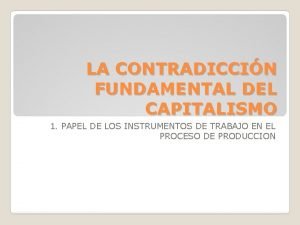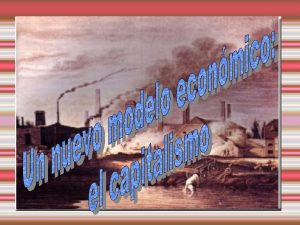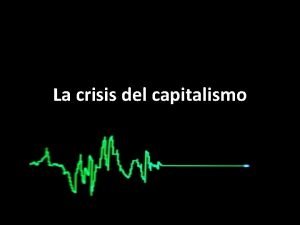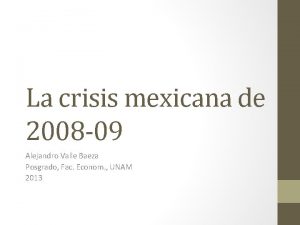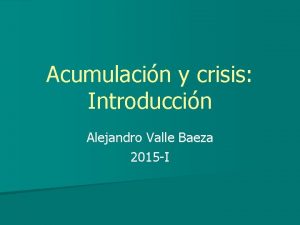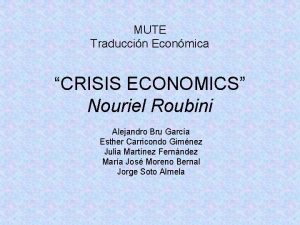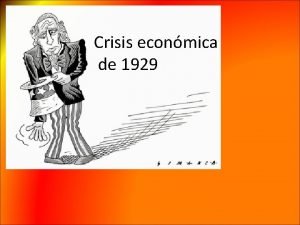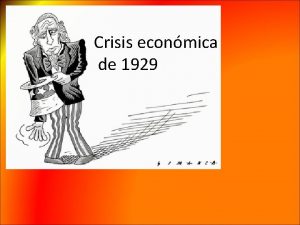Crisis econmica una consecuencia del capitalismo Alejandro Valle
























- Slides: 24

Crisis económica una consecuencia del capitalismo Alejandro Valle Baeza

Crisis • Una crisis capitalista es un súbito aumento de las necesidades insatisfechas al mismo tiempo que disminuye la ocupación de los trabajadores y de los medios de producción que satisfarían esas necesidades. De manera la población se empobrece porque se desaprovechan más los recursos de la sociedad capitalista y no por la carencia de éstos. • http: //economarx 21. files. wordpress. com/2011/1 1/crisis_definicion. pdf

Dos clases de crisis • Crisis períodica: ocurre aproximadamente en intervalos regulares. El de 10 años puede tener relación con el ciclo de vida del capital fijo. La crisis de estdounidense o la crisis mexicana de 2001 son dos ejemplos. • Crisis estructural u onda larga ocurre cada 30 o 50 años, puede relacionarse con grandes cambios técnicos y políticos. Las crisis mundiales de los años treinta o la actual son de este tipo.

Family that didn't even have shelter at a camp in Oklahoma City, Oklahoma.

• President Franklin D. Roosevelt's team wanted a record of what was going on -- and images of real lives and struggles to help rally support for his New Deal policies. • Over 170, 000 images were taken between 1935 and 1946 such as this one of a family that didn't even have shelter at a camp in Oklahoma City, Oklahoma. • Yale University and the Library of Congress have just made the entire collection available online on a site called Photogrammar.

Funeral procession of first death on project. Boy five years old. Red House Farms, West Virginia

One of many abandoned homes in the Widtsoe area. Utah Photographer Dorothea Lange

An impoverished American family living in a shanty during the Great Depression. Photographed by Dorothy Lange in 1936

Soweto township" by Matt-80

Street lights are not being replaced- in Detroit

The Lafayette Building in downtown Detroit. It was an office building that became defunct in 1997, and was torn down in 2009. It is an example of the urban blight that marks the once vibrant motor city.

This is a photo of a homeless man who died in a frozen block of ice

• Crime is at an all-time high (reduced police officers might play a pivotal role in this)- Detroit has one of the highest crime rates in the Country. According to Forbes, in a 2012 report, Detroit is the most dangerous city in the united States, for the fourth year in a row. Forbes stated that the metropolitan area had an unbelievable rate of violent crimes, murder, non-negligent manslaughter, forcible rape, robbery and aggravated assault. • The FBI reported that in the year 2013 alone there were 313 homicides, 809 sexual assaults, 5, 335 robberies, 8, 496 aggravated assaults, 12, 417 burglaries, 17, 453 larceny reports, and 12, 948 stolen vehicles.

The city of Detroit is flat broke. One of the greatest cities in the history of the world is just a shell of its former self • 1) At this point, the city of Detroit owes money to more than 100, 000 creditors. • 2) Detroit is facing $20 billion in debt and unfunded liabilities. That breaks down to more than $25, 000 per resident. • 3) Back in 1960, the city of Detroit actually had the highest percapita income in the entire nation. • 4) In 1950, there were about 296, 000 manufacturing jobs in Detroit. Today, there are less than 27, 000. • 5) Between December 2000 and December 2010, 48 percent of the manufacturing jobs in the state of Michigan were lost. • 6) There are lots of houses available for sale in Detroit right now for $500 or less.

• 7) At this point, there approximately 78, 000 abandoned homes in the city. • 8) About one-third of Detroit's 140 square miles is either vacant or derelict. • 9) An astounding 47 percent of the residents of the city of Detroit are functionally illiterate. • 10) Less than half of the residents of Detroit over the age of 16 are working at this point. • 11) If you can believe it, 60 percent of all children in the city of Detroit are living in poverty.

• 12) Detroit was once the fourth-largest city in the United States, but over the past 60 years the population of Detroit has fallen by 63 percent. • 13) The city of Detroit is now very heavily dependent on the tax revenue it pulls in from the casinos in the city. Right now, Detroit is bringing in about 11 million dollars a month in tax revenue from the casinos. • 14) There are 70 "Superfund" hazardous waste sites in Detroit. • 15) 40 percent of the street lights do not work. • 16) Only about a third of the ambulances are running. • 17) Some ambulances in the city of Detroit have been used for so long that they have more than 250, 000 mileson them.


• In 1937, on the eve of a major policy mistake, U. S. economic conditions were surprisingly similar to those in the nation today. Consider, for example, the following summary of economic conditions: (1) Signs indicate that the recession is finally over. (2) Short-term interest rates have been close to zero for years but are now expected to rise. (3) Some are concerned about excessive inflation.

• (4) Inflation concerns are partly driven by a large expansion in the monetary base in recent years and by banks’ massive holding of excess reserves. (5) Furthermore, some are worried that the recent rally in commodity prices threatens to ignite an inflation spiral.

• Liberty Street Economics June 01, 2011 • Commodity Prices and the Mistake of 1937: Would Modern Economists Make the Same Mistake? • Gauti Eggertsson • http: //libertystreeteconomics. newyorkfed. org

• Liberty Street Economics features insight and analysis from economists working at the intersection of research and policy. The views expressed are those of the authors, and do not necessarily reflect the position of the New York Fed or the Federal Reserve System.

THE GREAT DEPRESSION BEGINS: THE STOCK MARKET CRASH OF 1929 • The American economy entered an ordinary recession during the summer of 1929, as consumer spending dropped and unsold goods began to pile up, slowing production. At the same time, stock prices continued to rise, and by the fall of that year had reached levels that could not be justified by anticipated future earnings. On October 24, 1929, the stock market bubble finally burst, as investors began dumping shares en masse. A record 12. 9 million shares were traded that day, known as “Black Thursday. ” Five days later, on “Black Tuesday” some 16 million shares were traded after another wave of panic swept Wall Street. Millions of shares ended up worthless, and those investors who had bought stocks “on margin” (with borrowed money) were wiped out completely.

• The Great Depression (1929 -39) was the deepest and longest-lasting economic downturn in the history of the Western industrialized world. In the United States, the Great Depression began soon after the stock market crash of October 1929, which sent Wall Street into a panic and wiped out millions of investors. Over the next several years, consumer spending and investment dropped, causing steep declines in industrial output and rising levels of unemployment as failing companies laid off workers. By 1933, when the Great Depression reached its nadir, some 13 to 15 million Americans were unemployed and nearly half of the country’s banks had failed.

Article Details: The Great Depression Author History. com Staff Website Name History. com Year Published 2009 Title The Great Depression URL: http: //www. history. com/topics/greatdepression • Access Date November 11, 2015 • Publisher • A+E Networks • • •
 Consecuencias de la guerra del pacifico
Consecuencias de la guerra del pacifico Causas del pecado original
Causas del pecado original Consecuencia del embarazo adolescente
Consecuencia del embarazo adolescente Consecuencia política del imperialismo
Consecuencia política del imperialismo Myasthenic crisis vs cholinergic crisis ppt
Myasthenic crisis vs cholinergic crisis ppt Apuestas productivas del valle del cauca
Apuestas productivas del valle del cauca Gobernacion del valle del cauca
Gobernacion del valle del cauca V
V Presentaciones productos en arago
Presentaciones productos en arago Gobernacion del valle educacion
Gobernacion del valle educacion Consecuencias de la pesca
Consecuencias de la pesca Formula pq
Formula pq Conectores de consecuencia
Conectores de consecuencia Conectores de consecuencia
Conectores de consecuencia Idea tematica
Idea tematica Longitud de onda
Longitud de onda Salmo 23 texto completo
Salmo 23 texto completo Ventajas del capitalismo
Ventajas del capitalismo Evolucion del capitalismo
Evolucion del capitalismo Surgimiento del capitalismo
Surgimiento del capitalismo Contradicción económica fundamental del capitalismo
Contradicción económica fundamental del capitalismo Capitalismo e
Capitalismo e Etapa de la modernidad
Etapa de la modernidad Tendenze postimpressioniste
Tendenze postimpressioniste Diferencia entre comunismo y socialismo
Diferencia entre comunismo y socialismo




















